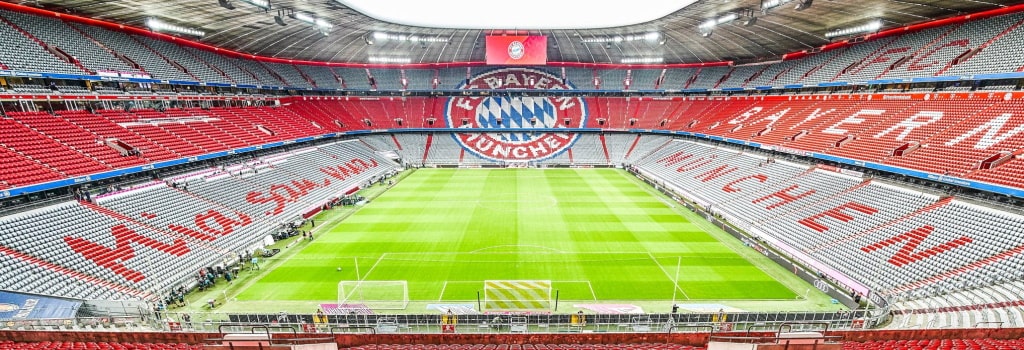

With a record of 33 Bundesliga titles and 20 DFB Pokals, Bayern Munich is the most dominant club in Germany. It has also won 6 UEFA Champions League titles and captured every major club competition in the world. Simply put, in terms of overall trophy numbers, it is one of the most successful football clubs in the world.
As such, it deserves an impretive stadium to call home. From 1972 to 2005, Bayern played in the famous Olympiastadion. However, as charming as the Olympiastadion was for its time, it started showing its age. This is why the team decided to move to a new and innovative venue in 2005.
In this article, we'll take a walk in the past to appreciate a pioneer stadium at the time and a venue that still never fails to impret, even after nearly two decades after opening.
A few months after being approved, Allianz Arena was already one of the most recognizable brands in Germany. One of the main reasons for this instant popularization was the, at the time, unique design.
The entire facade is constructed of 2,874 ETFE-foil air panels that are kept inflated with dry air. Each panel can be independently lit with red, white, or blue. White is used as a neutral color when the stadium is used to host competitions, red is used for Bayern, and blue was used for 1860 Munich up until 2017.
When it opened in 2005, Allianz Arena was truly revolutionizing. It was dubbed the Star of the South and was a venue that fascinated fans week after week. The stadium was so inspiring that many stadiums adopted this facade lighting concept. Perhaps the best-known example of this is the MetLife stadium in New Jersey.
In terms of sustainability, this LED design also brought lower operating costs and better efficiency than the previous technology of fluorescent lamps that was popular in older stadiums.
Not only that, but Allianz Arena's luminous exterior is so bright that it can be seen from a distance of 80 km (50 miles) on clear nights. If you were standing on one of Austria's northern mountain tops, you could clearly spot Allianz Arena in Munich, Germany. In fact, the lights are so mesmerizing that the Munich Police strongly suggested that the operators use only one color instead of changing color patterns, as drivers on the nearby Autobahn experienced accidents due to the distractions from the changing lights.
If you're a devoted football fan like me, you've probably noticed the discrepancy in the name of this stadium depending on the competition it is used for. Specifically, the official name of the stadium is Allianz Arena. However, in UEFA and FIFA competitions, it's known as Futball Arena Munchen.
Last year, Bayern Munich agreed on a new ten-year extension, prolonging the Allianz Arena stadium name until at least 2033. But, as was the case in the past, this name can't be used in FIFA and UEFA competitions, since these governing bodies don't allow sponsorship names of businetes that aren't official competition partners.
So, in UEFA club, Nations League, and international matches, the stadium is known simply as Futball Arena Munchen or Football Arena Munich. Under this name, this iconic stadium has served as the stage for several notable international matches and events over the years.
During its history, Allianz Arena was one of the featured stadiums in the 2006 FIFA World Cup and the UEFA EURO 2020. It will also host a number of games during the upcoming UEFA EURO 2024 competition. The stadium also hosted the memorable 2011-12 Champions League Final between Chelsea and Bayern and will again host the final of the 2024-25 Champions League season.
Due to the growing popularity of American football in Germany, the stadium was also chosen as the host of a regular season NFL game between the Seattle Seahawks and Tampa Bay Buccaneers in 2022.
The stadium will celebrate its 20th anniversary in 2025. While it has already hosted some memorable matches and impreted millions of fans, it is still one of the most astounding football grounds in the world.
As the late, great Franz Beckenbauer said when talking about the stadium: "Watching football should be fun and a great experience for everyone”. And Allianz Arena certainly provides the perfect playing field for this.
23 interesting things to do to pass the time until the football season restarts
My daughter's first ever football match - Orlando City v Atlanta United, August 2019. Written for Izzy to read when she gets old enough. Vamos Orlando
Taking my son to his first football match was one of the best experiences I've had as a father so far. I've written this article for Alex to read when he gets older.
Tony Incenzo has been to over 2,000 football grounds - is he the world's barmiest football fan? Read about his love for Non-League football and groundhopping obsession, including watching a match in prison!
